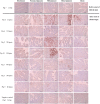The dynamics of a Chinese porcine G9P[23] rotavirus production in MA-104 cells and intestines of 3-day-old piglets
- PMID: 29553062
- PMCID: PMC5989024
- DOI: 10.1292/jvms.17-0657
The dynamics of a Chinese porcine G9P[23] rotavirus production in MA-104 cells and intestines of 3-day-old piglets
Abstract
Rotavirus A (RVA) G9 genotype is recognized as an emerging genotype which is spreading worldwide, however, our knowledge on pathogenicity of this virus is limited. In this study, porcine RVA strain HN03 was successfully isolated on MA-104 cells, and the isolate was propagated continuously for 7 passages after a virus cloning at passage 3. The virus titers from 4 to 10 passages ranged from 107.1 to 108.1 TCID50/ml. The growth curve of HN03 strain in cell culture was determined, and the virus production dynamics was confirmed by immunoperoxidase monolayer assay (IPMA). Sequence and phylogenetic analyses based on full-length VP7 and partial VP4 genes indicated that HN03 strain belongs to genotype G9P[23]. In addition, the sixth passage of strain HN03 in cell culture was subjected to 3-day-old piglets. All infected piglets developed severe watery diarrhea within 24 hr post-inoculation (hpi), but recovered from disease after 72 hpi. RVA antigen could be detected by IHC in the cytoplasm of villous enterocytes as early as 2 hr after appearance of clinical symptoms and virus antigen load kept increasing in the next 30 hr. The dynamics of RVA HN03 strain proliferation on cells and in pigs extended our understanding of rotavirus pathogenicity.
Keywords: G9 genotype; G9P[23]; pathogenicity; porcine rotavirus.
Figures




Similar articles
-
Evolutionary characterization and pathogenicity of a porcine G9P[23] rotavirus with gene segments linked to canine and giant panda strains.Virus Res. 2025 Aug;358:199600. doi: 10.1016/j.virusres.2025.199600. Epub 2025 Jun 15. Virus Res. 2025. PMID: 40527435 Free PMC article.
-
The dynamics of Chinese variant porcine epidemic diarrhea virus production in Vero cells and intestines of 2-day old piglets.Virus Res. 2015 Oct 2;208:82-8. doi: 10.1016/j.virusres.2015.06.009. Epub 2015 Jun 16. Virus Res. 2015. PMID: 26091822
-
Isolation, molecular characterization and evaluation of the pathogenicity of a porcine rotavirus isolated from Jiangsu Province, China.Arch Virol. 2015 May;160(5):1333-8. doi: 10.1007/s00705-015-2347-9. Epub 2015 Mar 6. Arch Virol. 2015. PMID: 25742930
-
Whole-genomic analysis of G3P[23], G9P[23] and G3P[13] rotavirus strains isolated from piglets with diarrhea in Thailand, 2006-2008.Infect Genet Evol. 2013 Aug;18:74-86. doi: 10.1016/j.meegid.2013.05.005. Epub 2013 May 13. Infect Genet Evol. 2013. PMID: 23681022
-
Rotaviruses: a review.Curr Top Microbiol Immunol. 1983;105:123-84. doi: 10.1007/978-3-642-69159-1_3. Curr Top Microbiol Immunol. 1983. PMID: 6313296 Review. No abstract available.
Cited by
-
CRISPR/Cas12a-Based One-Tube RT-RAA Assay for PoRV Genotyping.Int J Mol Sci. 2025 Jul 16;26(14):6846. doi: 10.3390/ijms26146846. Int J Mol Sci. 2025. PMID: 40725091 Free PMC article.
-
Molecular epidemiological investigation of group A porcine rotavirus in East China.Front Vet Sci. 2023 Mar 21;10:1138419. doi: 10.3389/fvets.2023.1138419. eCollection 2023. Front Vet Sci. 2023. PMID: 37026094 Free PMC article.
-
Evolutionary characterization and pathogenicity of a porcine G9P[23] rotavirus with gene segments linked to canine and giant panda strains.Virus Res. 2025 Aug;358:199600. doi: 10.1016/j.virusres.2025.199600. Epub 2025 Jun 15. Virus Res. 2025. PMID: 40527435 Free PMC article.
-
Recent Molecular Characterization of Porcine Rotaviruses Detected in China and Their Phylogenetic Relationships with Human Rotaviruses.Viruses. 2024 Mar 14;16(3):453. doi: 10.3390/v16030453. Viruses. 2024. PMID: 38543818 Free PMC article.
-
Establishment of a reverse genetics system for an epidemic strain of porcine rotavirus JXAY01 type G5P[23]I12.Front Vet Sci. 2025 Feb 12;11:1512327. doi: 10.3389/fvets.2024.1512327. eCollection 2024. Front Vet Sci. 2025. PMID: 40012614 Free PMC article.
References
-
- Amimo J. O., Vlasova A. N., Saif L. J.2013. Detection and genetic diversity of porcine group A rotaviruses in historic (2004) and recent (2011 and 2012) swine fecal samples in Ohio: predominance of the G9P[13] genotype in nursing piglets. J. Clin. Microbiol. 51: 1142–1151. doi: 10.1128/JCM.03193-12 - DOI - PMC - PubMed
MeSH terms
LinkOut - more resources
Full Text Sources
Other Literature Sources
Medical

